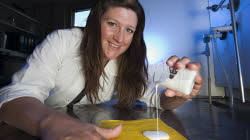In co-operation with research scientists and industry colleagues in eight countries, Susie Jahren, Stephan Kubowicz and their project team are developing the clothing of the future for professional fishermen. Midway in the EU project “Safe@Sea”, the SINTEF team has high hopes of ending up with a world first: at textile coating which automatically seals small holes and tears in the surface layer of waterproof work-wear.
“We have shown that the principle works. Holes and tears we have made in test pieces in the lab close up all on their own,” says Jahren enthusiastically.
Micro-capsules
The team has worked with the plastic material polyurethane, which is applied in liquid form to the surface of the underlying textile in modern rainwear and then hardens. To achieve a self-repairing effect, the SINTEF researchers have added micro-capsules containing a glue-like substance to the coating.
“If the coating tears, the capsules burst in the damaged area. Here the sealant content is released and hardens when it comes in contact with water and air, so the coating seals itself,” Jahren explains.
From structures to textiles
Not long ago “self-repairing materials” would have been considered science fiction. However, scientists in several parts of the world are now working on developing self-repairing plastic structures and plastic coatings to protect metals against corrosion. SINTEF is carrying on such research for the automotive industry, but until now nobody has produced textiles which repair themselves.
Jahren explains that the adhesion in the joins produced in laboratory tests is still mechanically weak, but that its strength can probably be improved significantly by using different types of “glue” and increasing the number of capsules.
“However, there are other challenges and a lot of research work ahead before we can say anything about how effective the method will be. We still don’t know what will happen if the tears are more than a couple of millimetres long, or whether rain will wash away the glue,” she points out.
At the limit
The EU “Safe@Sea” project will continue until the end of 2012. The work is being co-ordinated by SINTEF and managed by the Norwegian company Helly Hansen. Hilde Færevik, co-ordinating the work at SINTEF, says the ambition of self-repair has been included because the project team wants to test ideas which lie at the limit of what is technologically possible today.
“In this project we are at the same time developing durable coatings intended to reduce the likelihood of holes and tears occurring at all. The garments we are developing for fishermen will also include integrated floatation functions. We also plan to incorporate a man-over-board button in the clothing which sets off an alarm enabling fishermen to be located rapidly in the event of an accident.”

